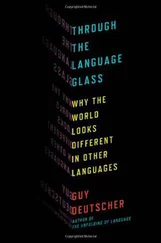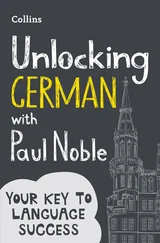We see how the language of film enters into language teaching with films. Our average high school student will not aspire to be a film critic or a film scholar. So it makes but little sense to systematically analyze the visual, the auditive, and the narrative qualities of a given film take by take, scene by scene.1 On the other hand, understanding content cannot discount form, that is, the way a story is constructed in the audiovisual medium, that is, the language of film.
The ending described so far is an open one. How will the story go on? Will our man succumb to quiet desperation, wait for the next tram, ride home and continue a lonely life? Not unlikely. Will he commit some act of violence, against himself or against the nearby laughers? Hardly. Will he haste after the woman, join her in the tram? Perhaps. Will they keep speechless and distant, or will they talk? Hard to tell. What will they talk about? Even harder to tell. Will they part as casual acquaintances? To be expected. Or will they have found the love of their lives, get married and live happily ever after? Probably not. The ending is open, but the subdued, laconic »language« of this film makes some endings more likely than others.
Here is the ending: After turning around from the laughter and realizing that the woman has gone, the man also takes off – whether to make the tram or run after the woman remains unclear. In any case, he ends up not in the same coach with the woman, but in another one. Leaning forward and resting his head on his elbows, he disappears from view as the train sets in motion from right to left (Fig. 2).
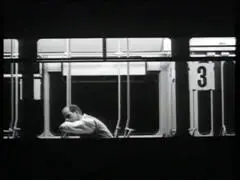
Fig. 2: Final view of the protagonist (0:07:05)
More than a hearty determination this motion indicates a quiet resignation. Ironically, the jacket the man would or could not part with has been left behind in the shelter. The ending still remains open, but it seems unlikely that anything will develop between him and her. Once again the leitmotif of the guitar chords can be heard. Also, the tram moves from right to left, which in our culture is a backward, not a forward move. On the other hand, the man has overcome his passivity and parted with his jacket. Maybe he has learned something and will change somewhat. Also, there is something new in the music, that is, a simple tune whistled above the chords. This well-crafted, detail-rich, and ambiguous ending demands close attention to filmic means, and it invites further interpretation: What, if anything, will come of it?
So far, I have left out the beginning of this film because the opening sequence requires ›higher‹ analysis and interpretation beyond the merely inner-textual content.
The protagonist comes out of a movie theater which advertises A STREETCAR NAMED DESIRE as that night’s feature film. He is being discharged into a dark night and rolling thunder. One last cigarette lit, then the doors close, and the lights go out (Fig. 3). The man strolls past a movie poster of BEN HUR, waves off a taxi and then walks across the street towards the tram stop.
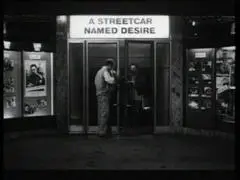
Fig. 3: From the movies into reality (0:00:58)
The intertextual references are too suggestive to be accidental. A STREETCAR NAMED DESIRE is Elia Kazan’s 1951 film based on the play by Tennessee Williams (1947). It is about an aging and fragile woman who in a futile and fatal manner clings to a long lost world of memories and illusions.1 While A STREETCAR NAMED DESIRE is about an unfulfilled and failed life, BEN HUR is the exact opposite. William Wyler’s 1959 film, a prime example of the sword-and-sandal genre, recounts the life of a man of action (aptly played by Charlton Heston), who endures and prevails by force of will and brain and muscle.
How do these films tie in with our film? For once, our protagonist is the utmost ironic opposite of Ben Hur. He has retreated from reality into the cinema to take in a melancholic melodrama. After the gates to the dream world have closed, he indulges in a cigarette and some afterthought before reality is calling from across the street in the form of a starkly lit tram station, where streetcars are not poetically named Desire but prosaically »No. 3«. The references to A STREETCAR NAMED DESIRE and BEN HUR thus suggest an interpretation of the main character: Here is a person to whom the cinema and the movies are surrogates for things missing in his life.
That is why the woman coming out of nowhere in the dark is so unsettling. Elegant, debonair, attractive, and self-confident, she looks as if descended straight from a movie screen. Except she is no apparition; she is the real thing. The way she is presented – in black and white, wearing an off-the-shoulder dress, smoking casually, sporting a tattoo – implies yet another intertextual reference, to the Hollywood genre of the film noir (Fig. 4). The classic period of the film noir lasted from the early 1940s to the late 1950s. Film noir stories typically center on sex and crime, stock figures of the genre being the hardboiled, cynical detective and a mysterious and lascivious femme fatale. The signal film of the genre was DOUBLE INDEMNITY (1944) by Billy Wilder, starring Barbara Stanwyck.
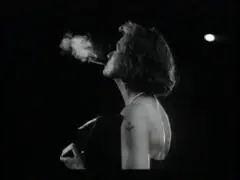
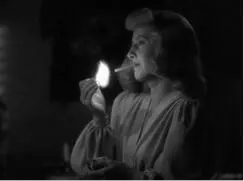
Fig. 4: Genre reference to film noir (0:04:19) (right: Barbara Stanwyck in DOUBLE INDEMNITY2)
Clearly, our smoking beauty is a genre reference to the film noir , which once again calls up and deepens the ironic contrast between the histrionic glamour on the movie screen and the trite realities of waiting for a tram. The film references (in combination with the mise en scène ) conjure up expectations of tragic romance, rough adventure, and erotic promise in a reality where nothing of all that materializes.
The innertextual make-up and the intertextual references account for a complex film, a rich aesthetic learning object. But alas! The characters in this short film remain speechless. No authentic native speaker material here. Also, this film is not set in an English-speaking environment, so there is nothing to learn about country and people, habits and customs. Our film is Swiss, its director is Laszlo Kish, its original title is GÄNSEHAUT (goose bumps). The story is rather archetypal, though, and clearly this 8-minute-film succeeds in packing a lot of meaning into a very small space. It employs well-wrought narrative patterns such as the division into three distinct parts (exposition in front of the cinema, main part in the shelter, coda in the tram), a careful structuring of space (with a street separating the illusionist world of the cinema from the real world of public transportation), and the best of all possible complications: the appearance of a woman1. More importantly, this film makes very effective use of the genuine language of film, which is not verbal but audiovisual: the black and white, the music (off scene) and the laughter (off screen), camera movement, field size, shot length. Last but not least, the meaning of this film draws heavily on intertextual references and ironies: A STREETCAR NAMED DESIRE, BEN HUR, the film noir . Like in a good poem or short story there is a density of aesthetic means and the kind of over-structuring we know to be the hallmarks of poetic texts.
Читать дальше






